CHARLOTTEVILLE ROLL OF HONOUR
1914-18 AND 1939-45Forename |
Surname |
Address |
Date Died |
Age |
| George | BAILEY | 95 Addison Rd | 5th July 1918 | 32 |
| Alfred William | BOXALL | 90 Addison Rd | 20th January 1918 | 46 |
| Frederick James | BROWN | 6 Cline Rd | 28th August 1915 | 26 |
| Henry Maurice | BROWN | 6 Cline Rd | 1st August 1918 | 24 |
| Rowland Ernest | BROWN | 6 Cline Rd | 7th May 1918 | 26 |
| William | COBBETT | 39 Addison Rd | 14th September 1914 | 31 |
| Frederick Charles | ETHERIDGE | 136 Addison Rd | 7th December 1918 | 21 |
| Walter George | FACER | 44 Cline Rd | 26th April 1918 | 24 |
| John Hector | HIBBERT | 18 Addison Rd | 23rd July 1918 | 21 |
| Edwin Henry | HILL | 16 Cooper Rd | 1917 | 37 |
| Frank Ernest | HILL | 16 Cooper Rd | 14th December 1916 | 32 |
| John Richard | HOOPER | 34 Addison Rd | 24th October 1918 | 23 |
| William | HOOPER | 34 Addison Rd | 9th April 1918 | 31 |
| Ernest William Edward | JELLEY | 67 Addison Rd | 10th September 1916 | 20 |
| Alfred Charles | KEMP | 95 Cline Rd | 30th October 1914 | 22 |
| Albert William | LANSLEY | 54 Addison Rd | 6th August 1915 | 23 |
| Arthur Ernest | NEWMAN | 52 Addison Rd | 10th June 1918 | 22 |
| Frederick William | NEWMAN | 52 Addison Rd | 21st August 1916 | 30 |
| Frank Richard | NEWMAN | 8 Cline Rd | 28th July 1918 | 24 |
| Albert John | POPE | 27 Cline Rd | 22nd February 1917 | 29 |
| George | PRICE | 3 Cooper Rd | 16th August 1917 | 32 |
| Albert Henry | SEPPLE | 124 Addison Rd | 21st October 1915 | 29 |
| Henry | SIVER | 113 Addison Rd | 21st August 1916 | 51 |
| Walter James | TUCKWELL | 59 Cline Road | 25th October 1918 | 26 |
| Thomas Walter John | WOOLDRIDGE | 66 Addison Rd | 8th April 1918 | 28 |
***** |
***** |
***** |
***** |
***** |
| Ronald Charles | DURBRIDGE | 37 Addison Rd | 22nd March 1941 | 20 |
| Adrian Walter | HAYES | 132 Addison Rd | 4th September 1940 | 23 |
| George Malgwyn | HAYES | 62 Addison Rd | 17th June 1944 | 28 |
| Reginald Arthur | KNAPMAN | 74 Cline Rd | 1st May 1943 | 31 |
| Peter Jessie | SNELLING | 125 Addison Rd | 6th April 1945 | 24 |
| Arthur Albany | PETERS | 45 Cline Rd | 26th May 1940 | 29 |
| Herbert Walter | WASHINGTON | 79 Cline Rd | 12th May 1941 | 38 |
Private 7742, 1st Bn., Bedfordshire Regiment, died of wounds, Friday 5th July 1918. Age 32.
George was the only son of Isaac and Elizabeth Bailey, and was originally from Loughton, Essex (CWGC and 1901 Census).
On 13th July 1918, the Surrey Advertiser reported his death as follows:-
"Pte. G. Bailey, Bedfordshire Regt., only son of Mr. And Mrs. I. Bailey, 95 Addison Road, died of shell wounds in France on July 5th. aged 32. He enlisted in the Bedfords at 18 and was called up on the reserve with the outbreak of war. He fought at Mons, Hill 60, on the Somme and at other well known places, and had escaped wounds and sickness up to the day of his death. In civil life he was a retort fitter at Kingston."
On the 28th June, 1918, the 1st Battalion Bedford's and the rest of the 5th Division, and the 31st Division, had established a front, just east of the Nieppe Forest. The German Spring Offensive had failed to break through to Hazebrouck and the Allies were hoping to prevent any further attempts (www.1914-1918.net).
The Battalion War Diary (National Archives ref WO95/1570) records that they relieved the 1st Bn Cheshire on 1st July and immediately set about improving the trenches and wire. In the next five days, enemy shelling with trench-mortars accounted for 4 Other Ranks killed and 14 wounded. On the 6th July, the Battalion withdrew to Arcade camp for refits, baths and rest.
George Bailey is buried in Aire Communal Cemetery, Pas de Calais, France. Grave Ref. III. H. 6. Aire is about 10 miles from the front-line at Nieppe Forest and in the War a casualty clearing station was based here (CWGC).
Return to Roll of Honour TableSergeant PLY/7565 (RMR/A/1072). H.M.S. "Louvain.", Royal Marine Light Infantry, died at sea Sunday, 20th January 1918. Age 46.
Alfred lived at 90 Addison Road (Oakley and Edwin Smith) and was the son of George and Hannah Boxall, Godalming and husband of Mary Boxall, 190 Franciscan Road, Tooting SW17 (CWGC).
The CWGC has the address for his wife Mary as Tooting but in "Guildford in the Great War" Oakley suggests she was at 90 Addison Road.
Before the War, Alfred had already served with the Marines for 21 years. He was awarded the China Medal (without clasp) in 1900 when he served on H.M.S. Terrible and the Long Service and Good Conduct Medal in 1907. Alfred left the Marines 16th July 1913.(from Royal Naval Division Casualties of The Great War, 1914-1924 on-line database, via Ancestry.co.uk)
He re-joined at the beginning of the War and took part in the early land battles such as the Defence of Antwerp in October 1914. He embarked H.M.S. Louvain 17th November 1914 and was mentioned in despatches 23rd May 1917.(from Royal Naval Division Casualties of The Great War, 1914-1924 on-line database, via Ancestry.co.uk)
Alfred was killed when HMS Louvain, an armed boarding steamer, was torpedoed by a German U-boat in the Eastern Mediterranean. The ship sank with heavy loss of life - 7 officers and 217 men (Jane's Fighting ships WW1, and Nat. Archives ADM1/8523/119).
Documents detailing the sinking and subsequent court-martial (National Archives ref ADM1/8523/119), show that HMS Louvain was on voyage from Malta to Mudros and was torpedoed at 9.30pm, on 20th January 1918, whilst passing through the Zea channel (between the islands of Zea, or Kea, and Makro Nisi). The ship sank almost at once, the engine room bulkhead having been burst by the explosion.
In the War Mudros on the Greek island Lemnos was an allied base in the Aegean, fifty miles south-west of the Dardanelles and an important staging post for military actions around Gallipoli.
The court-martial found that the large loss of life was due partly to the explosion itself and partly to the rush for lifeboats, their over-crowding and the lack of supervision in lowering them. Louvain had not been zig-zagging, as she should have been, but as the captain, Montague George Easton and the officer of the watch went down with the ship, no blame could be apportioned.
Up-date 07/02/2011- I have recently been in email correspondence with Thomas Easton, the grandson of the Louvain's captain Montague George Easton. He has kindly sent copies of the photographs below showing HMS Louvain and her Captain. He has anecdotal evidence from his grand-mother than Captain Easton was something of a cavalier character and would have been quite likely to dismiss official advice and instruction regarding which route to take and whether to adopt a zig-zag course. The court-martial did not to pursue this for the reasons above. This was war-time and mistakes and errors of judgement should not be considered in the same way as in modern, peaceful times.
Alfred Boxall is commemorated on the Plymouth Naval Memorial, situated centrally on The Hoe, Plymouth Devon. Panel No. 28.
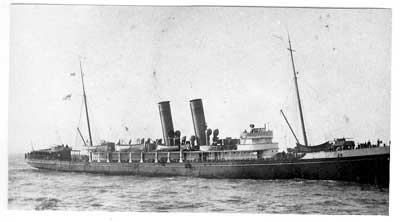
HMS Louvain copyright image by permission of Thomas Easton 2011
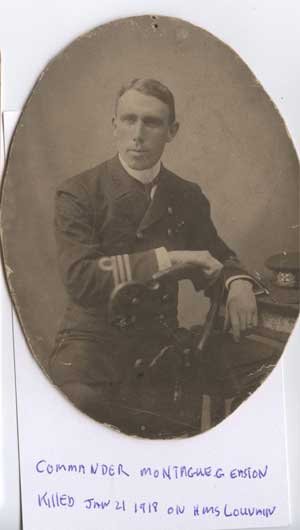
Montague George Easton, Captain of HMS Louvain copyright image by permission of Thomas Easton 2011
Return to Roll of Honour TableRifleman 3852 4th Bn Rifle Brigade, died 28th August 1915 age 25 years.
Frederick was the first of three brothers to be killed in the War. His two younger brothers, Rowland and Maurice both died on active service in 1918.
Frederick was the son of James, a bell-hanger, and Georgina Brown, of 1 Cline Road. He was baptised at Holy Trinity Church on 3rd June 1892 (Holy Trinity Baptism Records)
In 1901, the Census shows the family resided at 6 Cline Road, James the father was a 'whitesmith'. In addition to Frederick age 11, Rowland age 8 and Maurice age 6, there were two daughters, Edith and Constance, and a fourth son Francis, aged 1.
A whitesmith typically made utensils from tin, especially for dairy use.(Introduction to Occupations, Joyce Culley)
Frederick went to France with the 4th Rifle Brigade 20th December 1914 (Medal Roll Index, Natl. Archives). During April and May 1915, the battalion was involved in fierce fighting during the 2nd Battle of Ypres (Middlebrook, Your Country Needs You).
Under a ceaseless artillery barrage by the Germans the 4th Rifle Brigade helped to hold the front between Ypres and Frezenberg to the east. The battle only came to an end when the Germans finally ran short of shells.
During this period (22nd April to 14th May) the Battalion lost 75% of its men, killed, wounded or missing (Ray Westlake 'British Battalions On The Western Front January to June 1915')
The 4th Rifle Brigade moved to the Armentieres sector at the beginning of June 1915 and commenced tours of the trenches (Westlake).
I have been unable to find out more about Frederick's death on 28th August 1915. However, he is buried 1.5km west of Armentieres, in Desplanque Farm Cemetery, in the village of La Chapelle D'Armentieres. Grave A.6. In the War the farm was close to the front-line, and was used as a dressing station (CWGC).
Return to Roll of Honour TablePrivate 206659 2nd/4th Bn., The Queen's (Royal West Surrey Regt.) died of wounds, Thursday, 1st August 1918, age 22 years.
Henry Maurice was the third son of James and Georgina Brown, Cline Road. He was baptised at Holy Trinity Church, Guildford, on 25th February 1896 (Holy Trinity Baptism records).
The 1901 Census shows him at 6 Cline Road, age 6 years, with his three brothers, Frederick, Rowland, and Francis, and sisters Edith and Constance (see above).
The Surrey Advertiser, 17th August 1918, carried the following story:
"THREE BROTHERS KILLED - Pte H.M. Brown, 2/4th Queen's, brother of Mrs E. Bagg, 6 Cline Road, has died of wounds in France. He was 22, and a son of Mr. J. Brown, formerly employed by Messrs. Filmer and Mason, and had been serving three years, going to Egypt in 1916. Previously he worked at the Friary Brewery. Mrs. Bagg has now lost three brothers in the war, Pte. F. Brown, Rifle Brigade having fallen three years ago and Pte. R. Brown on May 7th last."
The history of the 2/4th Queen's Regiment is covered in "Croydon in the Great War" by H. Keatley-Moore and provides us with an idea of what the battalion had to contend with during the period that Henry Maurice was with them.
In Egypt and Palestine, the 2/4th Queen's were involved in several key battles, including the first Battle of Gaza, where the Queen's lost 200 men killed or wounded capturing heavily defended Turkish positions.
Much of the fighting was in intense desert heat but when the British reached Jerusalem, in December 1917, the weather changed to freezing rain and bitter cold winds. Still in lightweight clothing the Queen's overcame the cold to drive the Turks out of the hills with fierce fighting, much of it hand-to-hand, using bayonets, fists and anything that came to hand. Over 300 men from the Battalion were killed or wounded.
In June 1918, the Queen's were ordered to France to reinforce the Allied forces, now re-grouping after the German Spring offensive.
Joining the French armies, south of Soissons, the Queen's were soon involved in more fierce fighting and won much praise and respect from their French allies.
The Battalion war diary for the period leading up to Henry Maurice's death (Queen's Museum, Clandon) shows the Battalion were being constantly shelled and were either attacking, or defending counter attacks, in the area south of Soissons around the villages of Oulchy-la-Ville and Grand Rozoy. On the day he died, the diary records:-
"August 1st - The enemy re-opened his gas bombardment in the early hours of the morning. At 4am our barrage began, and at 4.45am our infantry advanced. A line, which was 1000 yards in rear of the Brown line near Hill 189, was taken by 6am. The early morning was misty but cleared later, and the French infantry could be seen passing through our line in perfect order". "There was heavy machine gun fire and the Flamenwerfer was used. The light French tanks prevented our being enfiladed."
Henry Maurice Brown died of wounds, 1st August 1918, and is buried Senlis French National Cemetery, Grave Reference II. D. 75. Senlis, is about 36 miles west of the battlefields around Grand Rozoy, and in the War was a centre for French Hospitals and casualty stations.
Return to Roll of Honour TablePrivate S4/070141, Royal Army Service Corps, died of sickness, Tuesday 7th May 1918.
Rowland was one of three brothers killed in the War (see Henry Maurice BROWN and Frederick James BROWN). In 1901, the Census records him, age 8, living at 6, Cline Road, with father James, a "whitesmith", and brothers Frederick age 11, Maurice age 6 and Francis age 1.
On Saturday, 18th May, The Surrey Advertiser, reports that Pte. R. Brown, A.S.C. (Guildford) "died of sickness".
Unfortunately, there is little information about Rowland's military service. The Army Service Corps, later known as the Royal Army Service Corps, was responsible for the transportation of food, clothing and ammunition to the front-line.
Rowland is commemorated on the Guildford Memorial but is not in the Roll of Honour compiled by Oakley. Intriguingly there is an entry by Oakley for "Pte H. Brown, Mechanical Transport, A.S.C., 7 Walnut Tree Close died of illness Ireland July 1917". Although this is the wrong date and wrong initial to be Rowland, I have searched the CWGC database and can find no H. Brown of the A.S.C., or any other regiment who died in Ireland in 1917. There is only Pte H. Brown, A.S.C., died July 1918 buried Guildford Stoke Cemetery.
Rowland is buried in Belfast City Cemetery, County Antrim, United Kingdom Grave Reference H. 537.
Return to Roll of Honour TableLance Corporal, L/7747, 1st Bn., The Queen's (Royal West Surrey Regt.) died Monday, 14th September 1914.
William Cobbett was the son of Mr. W. Cobbett, 39 Addison Road, and worked for the Guildford Post office (Oakley, Guildford and the Great War). He was the first Charlotteville man, to lose his life in the First World War.
He was born in Islington, London, 1885 and joined the army in 1903, at Guildford. William served with the 2nd Queen's in South Africa and Gibraltar (Army Service record, Ancestry.co.uk).
On 29th May 1909, William married Edith Holaship at Stoke Parish church, Guildford. They had two children, Edwin William born 16th January 1910 and Arthur James born 9th October 1911 (Army Service record Ancestry.co.uk).
After eight years service William left the army in December 1910 but was subsequently called-up from the Reserve at the outbreak of War in 1914.
William's Battalion, The 1st Queen's were assembled at Bordon, Hampshire, 4th August 1914, and were one of the first battalions to cross over to France, with the British Expeditionary Force (BEF). They left Southampton on SS Braemar Castle on 12th August and arrived at Le Havre the following day. (Battalion War Diary, Queen's Museum, Clandon)
Held in reserve during the Battle of Mons, the 1st Queen's were first called into action during the Retreat from Mons, when they took part in several rear-guard actions, as the British and French armies withdrew southwards. (Military Operations France and Belgium 1914, Brig. Gen. Sir James E. Edmonds, Macmillan 1933).
The weather was extremely hot and interrupted only by torrential rainstorms, which made the long marches very difficult. Constantly on the move and deprived of sleep, the men were totally exhausted, and when ordered to halt could only collapse where they stood.
After 12 days the Germans halted their pursuit, in order to re-group before the planned push towards Paris. However, on 6th September, the French took the opportunity to launch a surprise counter-offensive, later known as the 'First Battle of the Marne'.
By 7.30am, 9th September, the 1st Queens, the advanced guard of the 1st Division, were heading north, once more, and crossed the Marne at Nogent and entrenched on the heights north of the river. Surprised by the vigorous and aggressive advance by the British, the Germans continued to withdraw, many Germans being cut-off and taken prisoner.
Exhausted by the long retreat from Mons and fearing a German trap, the Allies now hesitated, and the Germans were allowed to withdraw to the north banks of the River Aisne.
The Queen's eventually crossed the River Aisne to Moulins,. on 13th September.
Entrenched on the "Chemin des Dames" ridge, the Germans were now in a strong defensive position, which forced the British to attack up-hill.
On 14th September, the 1st Queen's moved to Paissy, on the Chemin des Dames road, and advanced to the front of the wood near La Bovelle Farm, 1/2 mile north east of Cerny. Here 'B' and 'C' Company met serious opposition from rifle and machine gun fire, whilst 'A' and 'D' Company held a front along the edge of the wood. From here they were able to look down on and engage the German reserves in the Ailette Valley below, and to the North. As the German infantry attacked the French to the Battalion's right, the Queen's were able to inflict terrible casualties using their machine gun fire. (Battalion War Diary, Queen's Museum, Clandon).
The situation remained like this for several hours, during which time the Germans made several counter attacks at various points along the entire British line. These were all repulsed and at 3pm the Queen's were ordered to counter-attack the enemy's flank to the right, as they engaged the French infantry.
As the French retreated, the Queens were left facing large numbers of German infantry and to the left of the attack, 'A', 'B' and 'C' company suffered severe casualties and no officers remained. It was left to Lt. Colonel Warren to skilfully extricate the Queen's from their dangerously advanced position, and bring them back to the Chemin des Dames road by 4.30pm.
At the end of the day the 1st Queen's had lost 13 other ranks killed and 88 wounded. 39 other ranks remained missing.
One of these missing men was William Cobbett. He is commemorated on the La Ferte-sous-Jouarre Memorial, along with nearly 4,000 officers and men of the British Expeditionary Force who died between August and the early part of October 1914 and who have no known grave.
William's name is also on the Holy Trinity Church memorial and the Guildford Post Office Memorial (Surrey Advertiser, 12th June 1920).
In August 1915 his widow, Edith and their two children were awarded a weekly pension of 18 shillings and sixpence. William was still reported as "missing". In fact it was not until December 1916 when he was classed as "unofficially reported dead". (Army Service record Ancestry.co.uk).
Edith's address was still 39 Addison Road, although by June 1919 correspondence regarding her husband's medals was addressed to "Mrs. E. Riley, 39 Addison Road" so possibly she re-married. (Army Service record Ancestry.co.uk).
Return to Roll of Honour TableSignaller 179470, 128th Heavy Bty., Royal Garrison Artillery, died on Saturday, 7th December 1918. Age 21.
Frederick was the son of George and Jane Etheridge, of West Hill, Alresford, Hampshire (CWGC Citation).
The Surrey Advertiser, 14th December 1918, carried the following report:
"Death of Pte. F.C. Etheridge - the death took place in France on December 7th from pneumonia following influenza of Pte F.C. Etheridge RGA, youngest son of Mr. and Mrs. Etheridge, Pound hill, Arlesford, Hants. Pte. Etheridge was 21 years of age and joined up in February last, proceeding to France in September. Previous to joining he was employed at the Recruiting office, at St. Nicholas Hall, and for some time lodged with Mr. R. Lewis 136 Addison Road. Before the war he was a clerk at the Guildford Liberal Association's office. His older brother died of wounds and two other brothers are serving in France."
He is buried in Etaples Military Cemetery, France. Grave Reference XLVII. B. 20.
The area around Etaples was the scene of immense concentrations of Commonwealth reinforcement camps and hospitals. In addition, to the thousands of troops camped among the sand dunes there were eleven general hospitals, one stationary, four Red Cross hospitals and a convalescent depot. The hospitals could deal with 22,000 wounded or sick.(CWGC).
Frederick was one of 20 million victims of a special and virulent form of Influenza, which was to claim more deaths than the War itself. Known as "Spanish Flu", although the origin of the epidemic has never been determined, the virus struck in two waves, the first in mid to late 1918, the second in spring 1919, before it vanished as quickly as it arrived.
The influenza appeared to target young adults more than other age groups. It did not discriminate between rich and poor, military or civilians, nor racial background - India, Africa and the USA all suffered particularly bad outbreaks.
Recent research has attempted to link the outbreak with the vast military build-up at Etaples. Here chickens, pigs and vast numbers of men were all concentrated in a small area, with poor sanitary facilities, providing ideal conditions for the virus to develop into a most deadly form. (Oxford JS, Lambkin R, Sefton A, Daniels R, Elliot A, Brown R, Gill D., Vaccine. 2005 Jan 4;23(7):940-5)
Although the mass movements of troops and civilians certainly helped to spread the disease rapidly and to all continents, it is debatable that Etaples, or the War in general, were to blame for the pandemic.
Return to Roll of Honour TableWalter George Facer
Corporal 206545, 2nd/4th Bn, The Queen's (Royal West Surrey Regiment), died Friday, 26th April 1918. Age 24.
Walter was the son of John and Martha Facer, 44 Cline Road, Guildford. He was baptised at Holy Trinity church, 28th October 1894. The parish records show that his father was then a gardener, residing at 9 Cooper Road.
In 1901, John, Martha and Walter (age 6) were living in Cline Road, with Walter's sister Annie (13) and brother James (11) (1901 Census)
On 21st November 1914, the Surrey Advertiser printed a Roll of Honour, detailing all the Guildford men then serving in the War. The list included W.G. Facer, 5th Queen's.
Walter's battalion, the 2nd/4th, formed in April 1915, when the 2nd/5th (Guildford) merged with the 2nd/4th (Croydon). The Battalion history is graphically detailed in "Croydon in the Great War" by H. Keatley-Moore, on which the following summary is based.
After training at Cambridge and Bedford, they sailed for Gallipoli on 17th July 1915, aboard the Ulysses. (H. Keatley-Moore, Croydon in the Great War).
Landing at 'C' beach, Suvla Bay, 8th August 1915, the Queen's were soon in action. After fierce initial fighting the inevitable stalemate soon developed. Disease, floods and frost-bite, in winter blizzards, took their toll on the Battalion, not to mention those wounded or killed. Such was the devastating effect on the Queen's, that when the British and Anzac forces evacuated the Peninsula in December 1915, of the 1000 men that landed only 200 re-embarked.
Sent direct from Gallipoli to Egypt, the 2nd/4th Queen's were reinforced with large drafts of men sent from England.
In Egypt, the Queens helped build strong redoubts to protect the Suez Canal, and the battalion helped repel the eventual Turkish attack in August 1916.
In 1917, the 2/4th Queen's were involved in the Battles of Gaza, fighting German and Turkish troops in testing desert conditions
Fighting their way through Hebron and Bethlehem the Queen's arrived in Jerusalem on 10th December 1917. The weather had now changed and the Queen's still wearing their desert fighting gear were exposed to torrential rain and freezing temperatures.
The battle for the hills around Jerusalem now followed. The fighting was ferocious, often hand-to-hand, with bayonets and bare fists. However, the Turks were unable to win anything other than local successes. During these battles the Queen's were to lose 14 officers and 315 men, killed and wounded.
During the period January to March 1918, the Battalion had moved north as far as Jericho and spent much time defending the area from Turkish raids and digging trenches and defences.
In April 1918, the Queen's were in position on the Nablus Road at Ide Hill. On the day Walter Facer was killed the Battalion War diary (Queen's Museum, Clandon) reports the action as follows:-
26th April
0330 Fusilier Ridge and lower slopes to the west of Ide Hill were attacked
0410 firing had died down and situation appeared normal
0505 garrison at Abu Felah had withdrawn to its day bivouac position on south edge of village when the alarm was given. The platoon moved immediately to battle positions to North of the village and met with opposition from the enemy who had crept into the village.
0545 engagement had become general Abu Felah to Fusilier Ridge
0800 village clear
0845 Ide Hill still under pressure
0920 counter attack not strong enough to clear lower slopes
1125 whole reserve (C company less two platoons) ordered forward to clear front slopes of Ide Hill
1230 original line was regained and securely held. Fighting continued until dark.
The diary does not report how many casualties were suffered.
Walter Facer's death was reported in the Surrey Advertiser 18th May 1918, but no further details were given.
He is buried in the Jerusalem War Cemetery, which is situated at the northern end of the Mount of Olives. Grave reference L. 94.
Return to Roll of Honour TableJohn Hector Hibbert
Sergeant 206549, 2nd/4th Bn., The Queen's (Royal West Surrey Regt.) died Sunday, 23rd July 1918. Age 33. Note:- CWGC states J. H. Hibbert died in 1916, not 1918. Clearly a mistake, as newspaper and war diary evidence agree that 1918 is the correct year of death.
Up-date 16/06/2011 I wrote to CWGC and asked them to look at John Hibbert's year of death. After examining the evidence they have now changed the database to read 1918. The inscription on John Hibbert's headstone will be changed next time it needs replacing.
John Hector was the son of George William and Lucy Ann Hibbert, of 18, Addison Rd., Guildford. Parish records show he was baptised at Holy Trinity Church, 18th March 1896, and his father's occupation was a "Polisher".
The Surrey Advertiser, 21st November 1914 printed a Roll of Honour of "Surrey men serving their country" which included J. H. Hibberd, 5th Queen's.
As described earlier (see Walter FACER) the battalion was merged with the 2/4th Queen's from Croydon in April 1915. After suffering terrible casualties through enemy action and disease, in Gallipoli, during summer and autumn 1915, the Battalion was sent to Egypt.
From H. Keatley-Moore's history of the 2/4th Queen's, "Croydon in the Great War", we know that in Egypt and Palestine, the 2/4th Queen's fought bravely in many battles, under desert conditions, against German and Turkish forces.
After fighting their way up through Palestine to Jerusalem and Jericho, the 2/4th Queen's were sent by ship to France in June, 1918. After surviving an enemy torpedo attack the Battalion landed in Italy, before a 7 day train journey to the Western Front.
A period of training and reorganisation followed, before they were ordered to assist the French counter-offensive in the Soissons area, in July 1918.
A first objective of the French counterstroke was the road running between Soissons to the north and Chateau Thierry, which lies 16 miles to the south
The battalion's War Diary (Queen's Museum, Clandon) records the following:-
Under heavy bombardment, the 2/4th Queen's relieved the French Infantry at Parcy-Tigny, 22nd July 1918. Other Allied units were unable to make their objectives, so the attack planned for the morning of the 23rd had to be post-poned. Instead, 'B' Company, under 2nd Lieutenant Lessells, carried out a strong raid, on the village of Hartennes-et-Taux, destroying two enemy machine gun posts and causing the Germans to abandon their positions and weapons in panic.
The Battalion's War diary goes on to claim, that had 'B' Company been better supported, on either flank, they could have captured the village. However, with their flank exposed the Queen's had no option but to withdraw.
Eleven days later the Surrey Advertiser, 3rd August 1918, printed the following story, headlined "Sgt. J.H. Hibbert Killed in France",
"Within the last day or two Mrs. Hibbert, 18 Addison road, Guildford, has received a letter dated July 26th from Second Lieutenant Lessels, who belongs to Guildford and was recently gazetted to the Queen's, informing her that her youngest son, John Hector Hibbert, had been killed in action. The writer states that Sergeant Hibbert who belonged to his company, was killed early in the morning of the 23rd inst., instantaneously by a bullet in the head whilst leading his platoon into action. "Both myself and the whole platoon" he adds "desire to express our sympathy with you in your sad loss, which we appreciate, as he was well liked amongst his comrades, being always of a cheerful and willing nature and always striving to carry out his duties as only a British N.C.O. knows how. By his death I have lost the services of one of my best sergeants and comrades and my own house being in Guildford, we were townspeople and understood each other."
"Sergeant Hibbert was 33 years of age and before enlisting at the outbreak of War was a master cabinet maker and French polisher. He was a single man and served in the Dardanelles and also in Egypt and Palestine. He had been in a convalescent camp in Egypt following malaria and was transferred to France about a month ago. His mother had been expecting him home on leave and news of his death came as a terrible shock. Mrs. Hibbert has two other sons serving, Gnr. G.F. Hibbert, MGC, now in Egypt and Spr. T.J. Hibbert, RE, in Norfolk having been invalided from France."
John Hector is buried in Raperie British Cemetery, Villemontoire, Aisne, France, Grave Reference IA. D. 6. His body was probably brought here from one of the smaller Cemeteries at Parcy-et-Tigny, not long after the War finished.
As a footnote, the Surrey Advertiser 10th August 1918, reported that Second Lieutenant Lessels was killed in action on July 27th. He had been wounded by shrapnel two days earlier. The fragment was extracted and "he carried on until he met his death"
The CWGC records give the date of death as 29th July 1918. He is buried in the same cemetery as John Hector.
Return to Roll of Honour TableEdwin Henry Hill
Corporal 12454, SS/20172, Army Service Corps, died 1917. Age 37.
Both the Charlotteville and Holy Trinity Memorial include the name of E. Hill, but there are no E. Hill's with an obvious link to Charlotteville listed on the CWGC website, or in Soldiers Died in the Great War.
Initially Edward Albert Hill, Royal Sussex Regiment, was thought to be a possibility. Soldiers Died in the Great War shows he was born in Guildford but his CWGC citation states he is the son of Mrs. F. Wase, 15 Le Franc Road Worthing (CWGC). He is commemorated on the West Tarring Parish Church Memorial, Worthing, Sussex (www.Roll-of-Honour.com) No Charlotteville connection can be found relating to this memorial or in the Census or newspaper reports of the time.
Recent research has revealed that Frank Hill (see below) had a brother Edwin who died in 1917 but is not mentioned in CWGC.
Edwin was the son of Alfred and Olive Hill, 16 Cooper Road. He was baptized 5th September 1879 in Guildford. In 1881 the family lived at 5 Cooper Road and by 1891 had moved to number 11.
Army Service records show that Edwin joined the Army Service Corps in 1895, regimental service no 12454. He served 12 years including the Boer War and reached the rank of Corporal. He was awarded the Queen’s South Africa medal with clasps for Cape Colony, Paardeberg, Driefontain, Wittebergen, and Transvaal.
In 1901 Edwin was in South Africa with the Army whilst the Hill family were now at number 16 Cooper Road.
By 1911 the family were still at 16 Cooper Road but Edwin was lodging with the Goddard family at 30 Cline Road. He was occupied as a general labourer for a builder.
In September 1914 Edwin rejoined the Army, giving his address as 21 Cooper Road. He was attested to the Queens Royal West Surrey at Guildford but was subsequently discharged in December unlikely to become an efficient soldier
An article in the Surrey Advertiser in 5th October 1914 indicates that both Edwin and his father Alfred were carmen transporting livestock from Guildford Market.
In October 1915 Edwin re-joined the Army Service Corps but again was discharged within weeks due to ill-health. Edwin subsequently died in 2nd Quarter 1917.
Return to Roll of Honour TableFrank Ernest Hill
Private 5213, 13th Kensington Bn., London Regiment, died Thursday 14 December 1916. Age 32.
Frank was the son of Alfred and Olive Hill, of Cooper Rd., Guildford. He was born 13th September 1884 and baptised at Holy Trinity church on 7th November 1894. His father, Alfred, was a house painter. The 1901 Census shows the family at 16, Cooper Road, when Frank was 19 and working as a postman.
The 13th Kensington Battalion was part of the 168th Infantry Brigade, 56th (1st London) Division. The Brigade comprised territorials, from the London area and was formed, in France, in February 1916. The 56th Division fought its first battle on the first day of the Somme in 1916, when they sustained heavy casualties, whilst taking the first two lines of trenches at Gommecourt.
Life in the 13th Battalion, 'Kensingtons', is vividly detailed in a book by J.F. Tucker, "Johnny Get Your Gun" (Kimber, 1978).
Tucker's book mentions large drafts of men joining the Battalion in 1915, after they were decimated by casualties at the Battle of Neuve Chapelle and Aubers Ridge and again in early 1916, when the Brigade was re-organised in preparation for the Somme Offensive.
Heavy casualties during 1916, led to more men being drafted in from other regiments.
Frank Hill possibly joined the Battalion between the end of 1915 and Autumn 1916, either direct from England or transferred from another unit.
The Battalion remained on the Somme until 9th October 1916, and after several days re-organisation, were sent by train, to the Laventie area.
In contrast to the Somme, this sector was relatively quiet and any act of aggression, by either side, was met at once by retaliation, so there was little point in initiating such a move.
However, occasional shelling and sniper fire still accounted for many men, one man was killed and several injured when a shell fell on a ration party bringing food and ammunition to the front (Tucker).
Tucker's account also mentions that whilst on the Laventie front, the Battalion formed a section of 'scouts' to unsettle the Germans. These scouts would penetrate enemy lines and create what havoc they could.
He goes on to describe one unsuccessful bombing raid, where he helped to bring in two wounded men from the snow covered no-man's land. One man subsequently died of his wounds.
Frank is buried in Laventie Military Cemetery, La Gorgue, Nord, France, Grave Reference III. D. 22.
Return to Roll of Honour TableJohn Richard Hooper
Sapper 145032, 476th Field Coy., Royal Engineers died Thursday, 24th October 1918.
John Richard Hooper was the son of Mrs. E. Hooper, of 34, Addison Road.(CWGC) The 1901 Census shows John R. age 5, living in 36, Eagle Road, Stoke, Guildford. His father John was recorded as a carepenter/joiner, married to Eliza. John R. had two sisters Ellen (16) and Victoria (9 months)and a brother William (14).
The Company's war diary (WO95/3046) reports that on 23rd October the 476th Field company moved to St. Aubert, four miles east of Cambrai. Allied offensives in late September had broken through the Siegfried Line and by mid October were attacking the German second line of defence, known in this sector as the Hermann Line.
John's field company were making footbridges across the rivers to assist the attacking infantry.
On the 23rd October sections 1 and 3, of 476th Field Coy. were assigned to the 2/7th and 2/6th Royal Warwickshire Regiment respectively, at Montrecourt Wood, north-east of St. Aubert.
Zero Hour was on the 24th October and at 9.30 a messenger brought the news that Lieutenant Rose had been wounded but three bridges had been fixed. Total casualties for the day totalled 1 officer, 3 N.C.O.'s and 8 O.R.'s wounded. Five bridges were completed.
By 10.40, all the footbridges had been recaptured by the enemy.
John Hooper is buried in Awoingt British Cemetery. Grave reference, I. C. 24
Awoingt is a village, 2 miles, east-south-east, of Cambrai, where several Casualty Clearing Stations were posted. The great majority of the burials in the cemetery were made from these hospitals.
Return to Roll of Honour TableWilliam Hooper
Private 201847, 2nd/4th Bn., Dorsetshire Regiment, died of wounds Tuesday, 9th. April 1918. Age 31.
William resided in Weymouth, Dorset but was born in Stoke, Guildford (Soldiers Died in the Great War). The 1901 Census shows two William Hooper's of about the correct age in Guildford, but only one in Stoke district. William Hooper in Stoke is recorded in the same household as his brother John R. Hooper which would explain his inclusion on the Charlotteville memorial.
The 2nd/4th Dorsetshire Regiment formed in Dorchester in September 1914 and sailed for India in December same year. In August 1917 they left India for Egypt and by the end of the year had been attached to 234th Brigade, 75th Division.
In March 1918 the division was involved in the Battle of Tell'Asur and 9th - 11th April 1918 the Action of Berukin. Possibly William was injured in this second battle.
William Hooper is buried in Ramleh Cemetery, Israel. Grave Reference T. 36
The other William Hooper in Guildford 1901 Census (age 10) is most likely Private 4063, 1st/5th Bn., the Queen's Royal West Surrey Regiment. Died 21st June 1916. Age 25. He enlisted in Guildford, but was resident in Haslemere (Soldiers Died Great War).
The Surrey Advertiser, 2nd September 1916, reports, that:-
"Pte W. Hooper (D Coy Queen's) died of cholera June 21st. Home is Lion Lane, Shottermill"
Note, Shottermill is very close to Haslemere.
He is buried in Basra, Iraq.
Return to Roll of Honour TableErnest William Edward Jelley
Private 16939, 104th Coy., Machine Gun Corps (Inf) died Sunday, 10th September 1916. Age 20.
Ernest was the son of James and Sarah Jelley, of "Bexton," Weston Rd., Guildford, and resided at 67 Addison Road.
He was baptised at Holy Trinity, 31st May 1896, his parents James and Sarah gave their address as Addison Road, and his father's occupation as "gas stoker".
The Surrey Advertiser, 23rd September 1916, listed "killed, Pte. E. Jelley M.G.C. (Guildford)."
In the same edition, the paper carried the following story, under Local casualties.
"A Most Courageous Soldier - Pte. Ernest Jelley, Machine Gun Corps, son of Mr. and Mrs. J. Jelley of 67, Addison road, Guildford, has been killed in action. A letter from his sergeant states that he lost his life just as a German trench was captured. He was wounded and thinking his injury was slight, his corporal called out "Come on, Ern" but he just managed to gasp "I am going" and expired. Private Jelley, who was twenty years of age, was an expert gunner and joined the Army on September 9th, 1914, being killed on the second anniversary of his enlistment, and on his brother's birthday. Prior to the War he was employed by the Guildford Gas Company. His commanding officer has written to his parents that he was a most courageous soldier and devoted to his duty, while his sergeant states that he felt he had lost a brother. Pte. Jelley was an old Charlotteville school-boy and went through the Battle of Loos uninjured."
The Machine Gun Corps was created by Royal Warrant on October 14th, 1915, followed by an Army Order on 22nd October.
From Ernest's Medal Roll Index card (National Archives WO372) we know he went to France on 1st May 1915 as a Private soldier 10524, with the Royal Sussex Regiment.
Most Machine Gun Companies took their number from the Infantry Brigade to which they were attached. 104th MG Company joined 104th Brigade, 35th Division, in April 1916. One famous member of the same Brigade was Bernard Montgomery, "Monty", the great British military leader in the Second World War.
Other battalions in the 104th Brigade, were 17th Lancashire Fusiliers, 18th Lancashire Fusiliers, 20th Lancashire Fusiliers and 23rd Manchesters. There is no battalion from the Royal Sussex regiment in the 104th Infantry brigade or the 35th Division.
Formed in 1915 and ordered to France in early 1916, the 35th. was a Bantam division, so the infantrymen were below the normal minimum height of 5ft 3 inches, but officially above 5 ft. Some men shorter than this did manage to get accepted. When in the trenches the Bantams needed an extra sand-bag on the fire step, but, unsurprisingly, suffered fewer head wounds than their normal height counterparts.
Much of their fighting was on the Somme, where they performed admirably, particularly in the Delville Wood area.
The War diary for the 17/20 Lancs Fusiliers for the September 1916 (National Archives WO/95/2484) indicates the 104th Brigade were in the trenches just to the south-east of Arras. On the 9th September the 17/20th Lancs Fusiliers relieved the 18th Battalion and on the 10th sent out patrols under cover of darkness to harass and disperse German working parties.
Ernest is remembered on the Arras Memorial, France. Panel Number: Bay 10.
The Memorial commemorates almost 35,000 casualties of the British, New Zealand and South African Forces who died between Spring 1916 and 7th August 1918, excluding casualties of the Battle of Cambrai in 1917, and who have no known grave.
Return to Roll of Honour TableAlfred Charles Kemp
Private L/9817, 2nd Bn., The Queen's (Royal West Surrey Regt.) died Friday, 30th October 1914
Alfred Kemp was the son of Mrs. Kemp, 95, Cline Road. The St. Luke's parish register records the baptism of his son, George, on 8th. January 1912, when Alfred and his wife Alice resided at 59 Addison Road. His occupation was given as "soldier". Before the War he moved to Merrow and is also remembered on the Merrow War Memorial.
The Surrey Advertiser, 19th December 1914, reported his death as follows:-
"Private Kemp aged 22 lived at Holmesdale Cottages, Merrow and leaves a widow and one little child. His widowed mother lives at 95 Cline Road, Guildford. According to the official notification from the War Office received on December 10th he was killed in action on November 30th. He came with the 2nd Battalion from South Africa."
The 2nd Queen's were part of the 7th Division, who joined the British Expeditionary Force, at Ypres on 14th October 1914. The 7th Division were originally positioned to the east of Ypres, but as the 1st Battle of Ypres progressed they were moved south of the Menin Road. By 26th October the Division were defending the ground in front of Herentage Wood, until increasingly heavy attacks by the German 6th Army, forced them to withdraw to positions between Herentage Wood and Sanctuary Wood, a few miles south-east of Ypres.
By 27th October, the Germans were reinforced, by a further 6 divisions, and massive infantry attacks and heavy shellfire forced the 7th Division back into the woods. The woods provided good cover and the British rifleman's rapid fire technique convinced the Germans that they were facing a mass of machine guns.
Despite continuous and heavy attacks the British line held firm and the Germans failed to breakthrough.
Alfred's body was never recovered and he is remembered on the Menin Gate Memorial, Ypres. Panel 11 - 13 and 14. The Menin Gate Memorial .commemorates those who died in the Salient before 16 August 1917, and now bears the names of more than 54,000 officers and men whose graves are not known.
Up-date 31/01/2010 - I have recently heard from a nephew of Alfred, who after the death of his own father in the late 1930's, resided with Alfred's brother Frederick at 54 Cline Road. He was able to inform me that Alfred was one of six sons and one daughter, of George William and Sarah Kemp. He also recollected that George William had spent some time in South Africa.
From 1901 Census George and Sarah Kemp lived in Burpham Cottage, Worplesdon, with Alfred then aged 7. Sarah and their first child, daughter Annie, were both born Cape of Good Hope, South Africa. George William and all of his sons were born in Surrey or Aldershot.
Return to Roll of Honour TableAlbert William Lansley
Private 9981, 4th Bn., Worcestershire Regiment, died Friday, 6th August 1915. Age 23.
Albert Lansley was the eldest son of William and Jane Lansley of 15 Hill Place, Guildford. He was born in Guildford 13th September 1891.
Hill Place was later demolished and replaced by Bright Hill Car-park.
The 1901 Census, shows the family residing at 54 Addison Road. In addition to Albert there were three girls, Gertrude, Linda and Violet. William Lansley's occupation was "Bricklayer Labourer". In the 1911 Census, Albert was with the 3rd Battalion Worcestshire's stationed at Dover Castle. His occupation was musician.
The 4th Worcestershire Battalion were part of the 88th Infantry brigade, 29th Division. The 29th Division formed in early 1915 and comprised the last eleven battalions of regular troops, returned from the Far-East, together with one battalion of territorial troops from Edinburgh. The division was the last of Britain's regular army, so the decision to send it to Gallipoli, rather than the Western Front, was not popular.
The Division took part in the opposed landings on Helles beach on 25th April 1915. There followed three major battles, 28th April, 6th-8th May and 4th June, which pushed the Turks back, towards the town of Krithia. After 4th June, Allied advances were met with fierce Turkish resistance and no further progress was made. By this time British and Commonwealth forces had lost 40,000 men.
As stalemate developed the Allies opened up a new front at Suvla Bay, on the night of 6/7th August. To divert the enemy from this new front the 29th Division attacked at Helles at the same time. On the day that Albert was killed the 4th Bn Worcestershire suffered terribly as they attacked enemy positions around the Krithia vinyard. Estimates from contributors to the Great War Forum website suggest approximately of 800 men going into attack over 760 ended up as casualties. The Suvla Bay front also resulted in stalemate trench warfare, and the troops were evacuated four months later.
Eventually, troops on the Helles front, including the 29th Division, were evacuated in January and February 1916, and sent to the Western Front to take part in the First Day of the Battle of the Somme, on 1st July.
Albert was killed in action in Gallipoli and his body never recovered. He is commemorated on the Helles Memorial, Turkey. Panel 104 to 113.
The memorial stands on the tip of the Gallipoli Peninsula and bears the names of some 21000 men, from all over the World, who fell on the Peninsula and who have no known grave.
Return to Roll of Honour TableArthur Ernest Newman
Air Mechanic 2nd Class 407942, died Monday 10th June 1918. Age 22.
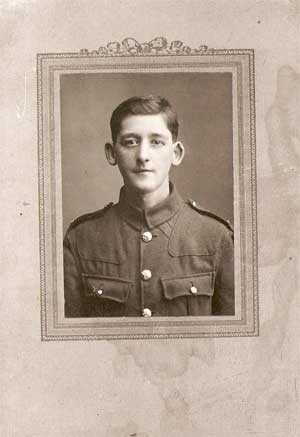
Arthur Newman (copyright image by permission of Nigel and Val Crompton 2011)
Arthur Newman was the son of Charles and Annie Newman, of 52, Addison Rd., Guildford. The 1901 Census records the family residing at 81 Addison Road. In addition to Arthur age 5, there were three other boys, Cecil, age 17, a baker, Frederick age 14, a garden boy, and Harry age 10. There were also four sisters Grace, Daisy, Edith and Dorothy. Charles Newman was a "Jobbing Gardener".
The Surrey Advertiser, 28th August 1915, reported that Private 3293 A.E. Newman 2/4th Queen's had been wounded at the Dardanelles. It printed a copy of the letter received by his parent's.
"Wounded in the Leg - Pte Arthur Newman, son of Mr. and Mrs. Charles Newman, 52 Addison Road, Guildford, in a letter received on Sunday, says:- "I have been wounded in the right leg just above the knee. The best of things was we only landed on Sunday night late and by Monday dinner time I had been wounded". Describing what things were like, he wrote:" They say it was hell in France, but it is worse out here'. His was the first company in the battalion and the regiment was the first in the division to go to the trenches." There are a lot of our chaps with me I have lost everything I have, even my right trouser leg!" It also appears from the letter that the battalion lost one man on the outward voyage through a fall. Before the war Pte Newman was employed in the bicycle workshops of the Halford Cycle Company in the High Street Guildford. Mr and Mrs Newman have five sons* and two son-in-laws in the services. Their sons are Corpl. Cecil Newman who is with the Army Veterinary Corps; Corpl. Fredk. Newman, RFA;Tpr. Harry Newman 3rd Dragoons and Pte. Arthur Newman who is 20 years of age of the 2/4th Queen's. One of the sons in law is in the Royal Engineers and the other at the Dardanelles."
*(I think this is an error, and should read three sons and two sons in law, five in total)
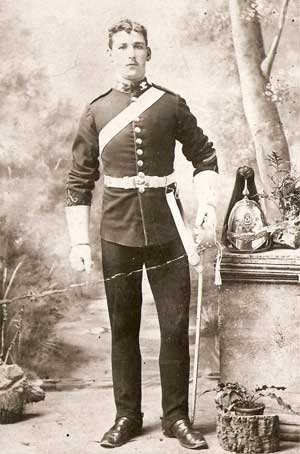
Arthur's brother, Harry Newman, 3rd Dragoon's (copyright image by permission of Nigel and Val Crompton 2011)
Another letter, from Pte Brown of Merrow, published in the same paper gave a vivid description of the same action.
"There were shrapnel and bullets all over the place. What with our aeroplanes dropping bombs and warships firing the din was awful. You have no idea what it is like. A lot of the Queen's were hit before they had a chance to defend themselves. The Turkish snipers are fine shots. They paint themselves the colour of the landscape. We caught one who turned out to be a woman. She had 50 identity discs, which meant she had accounted for 50 of our chaps. There are about 20-30 Queen's in this hospital, which consists of little huts of four beds in each."
Arthur's brother, Frederick, was killed almost exactly one year later, 28th August 1916 in France. In the newspaper report of his death, Surrey Advertiser 2nd September 1916, it mentions that his brother, Arthur Newman, "still suffers from the effects of a wound sustained twelve months ago in the Dardanelles".
Arthur died in the City of London Hospital, Victoria Park, London, nearly 2 years later. He is buried in Guildford, Stoke Old Cemetery, Grave G. 372.
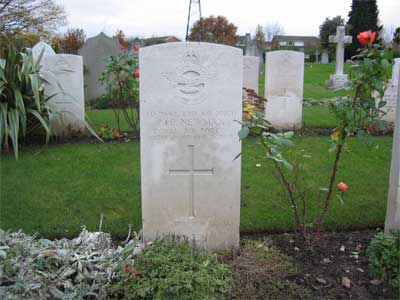
Frederick William Leonard Newman
Sergeant 90340, "C" Bty. 109th Bde., Royal Field Artillery, died Monday 21st August 1916. Age 30.
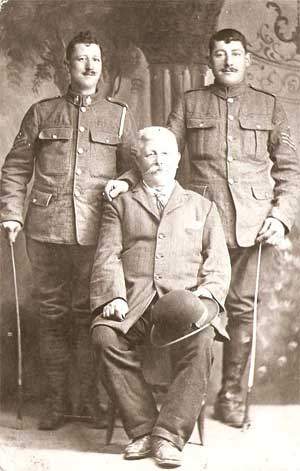
Frederick Newman is on the right of picture. His father, Charles is seated. Frederick's brother, Cecil, is standing on left (copyright image by permission of Nigel and Val Crompton 2011)
Frederick was the son of Charles and Anne Newman, 52 Addison Road and the husband of Mrs. Frederick Newman, of 5, Keens Buildings, The Mount, Guildford.
He is the brother of Arthur Newman, also commemorated on the Charlotteville Memorial.
The 1901 Census shows him, age 14, living with the rest of the family, at 81 Addison Road. His occupation was "garden boy domestic", and his father, Charles, was a "jobbing gardener".
Frederick was the second eldest boy, his older brother, Cecil, 17, was a baker, and he had two younger brothers, Harry, age 10, and Arthur, then 5. There were also four sisters, Grace, Daisy, Edith and Dorothy.
In August, 1915, his brother Arthur was injured at the Dardenelles, and the Surrey Advertiser, 28th August, published a letter sent, by Arthur, to his parents. At the end of the article there is a mention that Cecil, Harry and Frederick were all serving. Cecil, a corporal with the Army Veterinary Corps, Harry a trooper, in the 3rd Dragoons and Frederick a corporal in the RFA.
Twelve months after the letter was published Frederick was killed on the Somme, and the Surrey Advertiser, 2nd September 1916, printed the following:-
"Farrier-Sergt. Frederick William Newman of the RFA, whose wife and two children reside at the Mount, Guildford, has been killed. The second son of Mr and Mrs C. Newman, of 52, Addison Road, Sergt. Newman was 30 years of age and joined the Army at the outbreak of the War. A letter from an officer states that he was badly wounded by a bomb dropped from a hostile aeroplane when he was working at his forge in the artillery lines. He was taken to the dressing station where he called out for his wife to make him a cup of tea and then expired. Prior to the War Sergt Newman was employed for 12 years by Mr. May of Guildford. One of his brothers Farrier-Sergt. Cecil Newman is in the A.V.C., another Trooper Harry Newman is with the 3rd Dragoons; and yet another, Pte Arthur Newman still suffers from the effects of a wound sustained twelve months ago in the Dardanelles."
The War Diary for 109 Brigade Royal Artillery (PRO Ref WO95/2198) refers only briefly to the incident, describing the 21st August as a "fairly quiet day", mentioning that "an aeroplane bombed wagon line. 1 killed, 6 wounded". The brigade were positioned at Bois des Tailles, due south of Meaulte and some miles from the front-line. The wood was used as a training camp and troops often bivouacked here before moving up to the front.
Frederick is buried in Meaulte Military Cemetery, Somme, France. Grave reference E. 28. Meaulte was some distance from the front, and was used as a base for hospitals, headquarters and for civilians.
Up-date 25/07/2010 I have received an email from Frederick's grand-daughter, Val, who recently visited Frederick's grave and kindly sent me some photographs.

Frederick Newman's entry in the cemetery register, Meaulte Military Cemetery, 2010

Frederick Newman's Grave, Meaulte Military Cemetery, 2010
Richard Frank Newman
Private 46262, 23rd (Tyneside Scottish) Bn., Northumberland Fusiliers, died on Sunday 28th July 1918.
Richard was the son of Mrs Newman of 8, Cline Road, Guildford.
The Surrey Advertiser, 27th April 1918, listed him as missing in action, and the same paper on 1st. June confirmed him as a Prisoner of War.
On the 16th November 1918, the Surrey Advertiser reported his death, as follows:-
"Mrs. Newman, 8 Cline Road, Charlotteville, has received news that her son Pte. Richard F. Newman, Northumberland Fusiliers has died in Germany while a prisoner of war. It was sent by a fellow prisoner, a London Rifleman, who stated that her son died after a week's painful illness. Pte. Newman was taken prisoner in the German advance in March last. He had been in France close upon two years. Formerly he was in the employ of Messrs. Fogwill coal merchants and he leaves a widow and two children, who are now living at Haslemere."
German POW records show that he was captured at Bullescourt on 21st March 1918 and sent to Dulmen prisoner of war camp. The record shows he died of pneumonia on 28th July 1918.
Richard is buried in Cologne Southern Cemetery, Germany. Grave XIII. F. 6.
There are over 2000 Allied servicemen buried in the cemetery, many having been brought here from other cemeteries, in other parts of Germany, at the end of the War.
Return to Roll of Honour TableAlbert John Pope
Private, G/62784, 7th Bn., Royal Fusiliers, died Thursday, 22nd February 1917. Age 29.
Formerly Private 5267 5th Bn Queen's killed in action, enlisted and was resident in Canterbury (Soldiers Died in the Great War).
Albert Pope was the son of Charles Henry and Mary Ann Pope, of 27, Cline Rd., Guildford. He was baptised at Holy Trinity Church on 26th August 1890, at which time his parents address was 6 Warsley Farm, Cline Road.
In 1901, the family were living at 27 Cline Road. In addition to his father, Charles, who was a house painter, there were four boys, Charles, aged 16, George, 14, Albert, 12, and William, 6. There were also three sisters, May, 11, Florence, 9 and Louisa, 4. By the 1911 Census, Albert had left home and was a picture framer's journeyman. He was boarding with a picture framer and his wife, in Porchfield, near Newport, Isle-of-Wight.
The 7th Battalion Royal Fusiliers were part of the 63rd Royal Naval Division. The division was formed to accommodate the Royal Marine and Royal Naval reservists, who were needed far more in the trenches than at sea, in what was predominantly a land war.
In 1916, the Royal Naval Division was ordered to the Western Front and re-organised into three brigades, two brigades were comprised solely of Royal Naval battalions, whilst the third, the 190th was formed entirely from army battalions, and included the 7th Bn Royal Fusiliers.
The Division's first battles on the Western Front were in the closing stages of the Battle of the Somme, when they took part in the capture of Beaucourt-Sur-Ancre, 13th November 1916. A memorial to the Division now stands in this village.
By February 1917, the 7th Battalion Royal Fusiliers were still positioned in the Beaucourt sector. The Battalion's War Diary (WO95/3119) records the following sequence of events:-
10th-13th February - Beaucourt Trench and Suvla Trench under heavy bombardment by gas shells
15th February - to billets in Martinsaart. Heavy rain and the roads flooded.
19th February - new drafts received from East Surrey Regiment and the Queen's
20th February - raining hard, proceeded to line to take over from 2nd Battalion R.M.L.I. Hamel at 5.15pm, relief difficult because of heavy mud. Men wearing gum boots. 'A' Coy left flank, 'B' Coy Pensive(?) Trench, 'C' Coy Sunken Road, 'D' Coy Old Shell-hole Line. BHQ in Puisieux Trench.
22nd/23rd February - Several casualties due to heavy shelling during the night
24th February - everything suspiciously quiet
In fact, the Germans had withdrawn 23rd/24th.
Albert is buried in Ancre British Cemetery, Beaumont-Hamel. Grave VI. A. 19.
Return to Roll of Honour TableGeorge Price
Private 25993, 7th Bn, Somerset Light Infantry, died Thursday 16th August 1917. Age 32
The CWGC citation states that George was the son of George Price, 3, Cooper Road, Guildford and husband of Susan Ann James (formerly Susan Ann Price) of Blackwood, Newport, Monmouthshire. Soldiers Died in Great War states he enlisted in Bath, Somerset.
In 1901, the Census showed George (senior) a furniture packer, at 3 Cooper Road with wife, Mary. They were born in Herefordshire and Worcestershire respectively. They had a daughter, Cristina, age 27, a nurse domestic, and two sons, George, age 15, an errand boy, and Charles W. age 12.
George married Susan Anne Townsend, daughter of William Richard Townsend, at Holy Trinity Church, 3rd August 1909. His occupation then, was "Upholsterer".
In November 1911, George and Susan Anne had their daughter, Christine May, baptised at St. Lukes Church. They were then living at 37 Cline Road. (St. Luke's Baptism Registers)
Up-date 09/02/2011- The history of George's battalion in World War I is detailed in a book by Brendon Moorhouse, "Forged by Fire - the Battle Tactics and Soldiers of a WW1 Battalion", Spellmount 2003. There is a copy in the reading room at the Imperial War museum, London. The account mentions George's death in some detail.
"In Bath, the seven year old daughter of a former furniture packer, Private George Price, waited eagerly for the post on her birthday. When none arrived she asked her mother "I wonder why Dad hasn't sent a birthday card" The answer came in the later post with a letter from Lt Spark. The brave fellow met his death in an attack on enemy trenches from a shell. He died almost instantly and suffered no pain. He is buried in the village he helped to capture and a cross marks his grave. The Regiment has lost a good soldier. George Price left three younger children."
The 7th Somerset Light Infantry took part in the Battle of Langemarck, beginning early in the morning of 14/8/1917. They were issued with ammunition, flares and bombs at Magenta farm. At 7pm a 5.9" shell landed amonst a group of 30 men, killing eight and injuring 18. The remaining men continued on to the front-line where they waited on the west bank of the Steenbeek, upto their knees in water, until nightfall.
As night fell on 15th August the Royal engineers bridged the stream and company by company the battalion crossed the river, under sporadic shell-fire and occasional machine gun and rifle fire. At dawn on 16th August the British artillery began a barrage which was met by a counter barrage from the German side. As the Somerset's stormed the Au Bon Gite many were cut-down by machine gun fire, despite the cover of smoke bombs. Struggling across boggy ground full of shell holes the men sank up to their knees in the mud. By the end of the battle the division as a whole had taken 400 prisoners, captured 30 machine guns and a battery of four 4.2 inch howitzers and a 7.7cm field gun. George's battalion lost 44 men killed and 226 injured.
George Price has no known grave and is commemorated on the Tyne Cot Memorial, near Ypres, Belgium. Panel 41 to 42 and 163a.
The memorial bears the names of nearly 35,000 men who have no known grave and fell in the Ypres Salient, between 15th August 1917 and the end of the War.
George's younger brother, Lance-Cpl C.W. Price was in the Machine gun section attached to the Royal Fusiliers. The Surrey Advertiser, 14th July 1917, reported that C.W. Price, youngest son of Mr. G. Price, 3, Cooper Road, was awarded the Military Medal for brave and cool conduct in the field during the advance on July 7th. He was slightly wounded but recovered after 2-3 days in hospital.
C.W. Price joined up on 8th April, 1916 and went to the front on 23rd August 1916. Before the War he was a French Polisher by trade.
The article does not mention his brother, George.
Return to Roll of Honour TableAlbert Henry Sepple
Private 8574, 1st Bn., Leicestershire Regiment, died Thursday, 21st October 1915. Age 34.
Albert was the son of Charles and Mary Sepple. The 1891 Census shows the family in Aldgate Circus, London. Both the parents and eldest children, including Albert, are shown to be born in Germany. The 1901 Census shows Charles and Mary Seppel, or "Szepel", residing at 124 Addison Road, with two sons, Charles(16) and Herman(5), and four daughters. Albert, age 20, is not recorded as living with them.
Charles and Mary Sepple were both born in Germany and were German subjects. Charles' occupation was given as "Tailor". In the 1911 Census, Albert was with the 2nd Leicestershire's stationed in India. His birthplace is now recorded as Middlesex, London.
Albert Sepple married Hannah Louisa Roden, 23rd January 1915, at Holy Trinity, Guildford. The marriage certificate describes Albert "Seppel" as a resident of Cosham, and serving in the 2nd Battalion Leicestershire Regiment. The certificate also confirms Albert's father as Charles John Seppel, tailor.
Both the 1st and 2nd Battalions, Leicestershire Regiment spent the first months of 1915 in the trenches south of Armentieres. In March the 1st battalion moved northwards towards Ypres to support the 27th Division, whilst the 2nd remained to fight at the Battle of Neuve Chappelle.
It is not known when Albert was wounded, but he died in Norfolk War Hospital, Thorpe St. Andrew, Norfolk, 21st October 1915. He is buried in Guildford Cemetery,The Mount grave number 4897.
Hannah Sepple went on to marry an Australian Machine Gunner, William Windreas, 28th May 1917, at Holy Trinity, Guildford. After the War she settled in Queensland, Australia. William Windress' service record shows he was admitted to Guildford War Hospital, Warren Road, in January 1917. He was suffering from Trench Fever.
Note: CWGC gives Albert's age as 29, yet his marriage certificate suggests he was 34. Soldiers Died in the Great War gives his birthplace as Whitechapel, London.
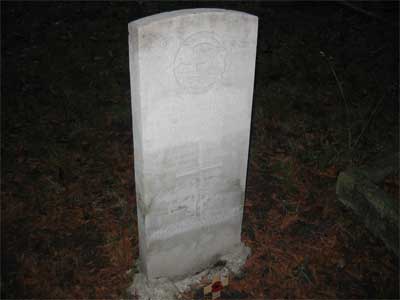
Albert Sepple's Grave, Guildford Cemetery, The Mount - 2008.
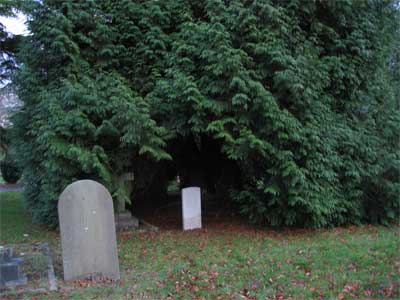
Albert Sepple's Grave located under the tree - 2008. In recent years the tree has been cleared.
Henry Siver
Sergeant CH/2147, Pensioner H.M.S. "Ebro", Royal Marine Light Infantry, died Monday, 21st August 1916. Age 51.
Henry was the son of William Siver; and husband of Sarah Siver, of 113, Addison Rd., Guildford.
From "Royal Naval Division Casualties of the Great War" (an on-line database via Ancestry.co.uk) we know Henry was born 16th August 1863, St. George's London. He received his Royal Navy Long Service and Good Conduct Medal 6th December 1891 and completed his service in December, 1902.
At the outbreak of war he joined the Royal Naval Division, a division created to strengthen the Army with Marines and sailors. Henry was in Chatham battalion and took part in the Defence of Antwerp, October 1914. He transferred to H.M.S. Ebro 12th April 1915 where he served until his death from disease in 1916.
HMS Ebro was an armed merchant cruiser, part of the Navy's 10th Cruiser Squadron. The Squadron was formed entirely of merchant ships, and included all sizes of vessels, from liners to trawlers, and they were used to enforce the blockade of Germany. Most of the time HMS Ebro operated off the coast of Norway, although occasionally was called to operate between Scotland and Iceland.
HMS Ebro was not in action at the time of Henry's death.
The following report appeared in the Surrey Advertiser, 2nd September 1916:-
"Died at Sea - Siver, Sgt. H. RMLI (Guildford)"
later in the same issue
" An intimation has been received by Mrs. Siver of 113 Addison Road, Guildford, of the death of her husband Henry Siver, RMLI. The late Sgt. Siver had a long record of service. He was with his unit for 21 years and was afterwards a pensioner for 10 years, rejoining the Navy on August 4th 1914. He had a Long Service Medal and on taking up his pension was for some years a War Office clerk in Edinburgh. He came to Guildford 4 years ago and was employed by Messrs. May and Jacobs."
Henry was buried at sea, and is commemorated on the Chatham Memorial, Panel 18, along with 8,000 other sailors, all with no grave, having been lost at sea.
The logbooks of HMS Ebro and HMS Almanzora are now available to read on-line at www.naval-history.net. The following links will take you to the ships' logs. HMS Ebro and HMS Almanzora
The entries for 20th August 2016 show that Henry was transferred from HMS Ebro to the hospital on-board HMS Almanzora. The positon of the ships was off the north-coast of Iceland. The following day the logs show a burial service was held on both ships. The service on the Almanzora was followed by the burial at sea. The ship's position was now to the west of Iceland.
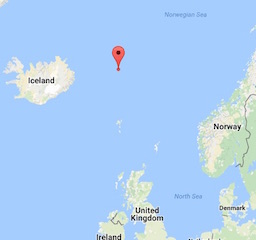
Position of HMS Almanzora when Henry Siver was buried at sea. Image courtesy of Google Maps.
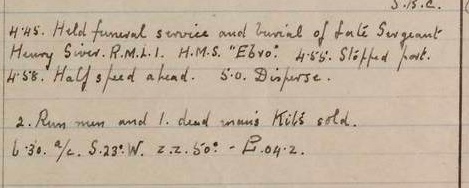
Excerpt from HMS Almanzora Log entry 21st August 1916
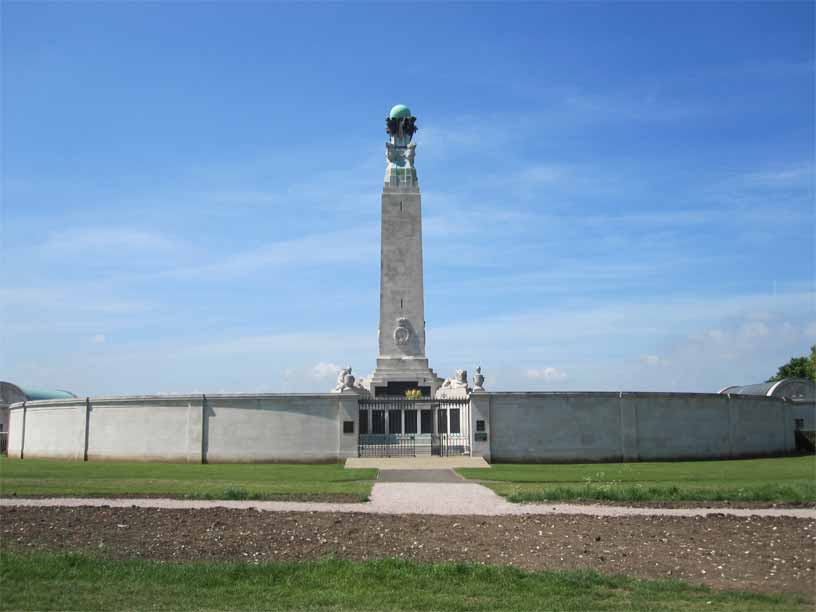
Chatham Naval Memorial, Kent 2010
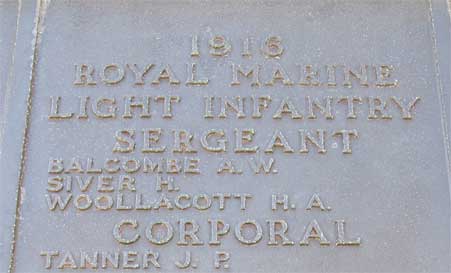
Henry Siver, Panel 18, Chatham Naval Memorial 2010
Walter James Tuckwell MM
Lance Corporal 2022, 7th Bn., The Queen's (Royal West Surrey Regt., died Friday, 25th October 1918. Age 26.
Walter was the son of James Tuckwell, of 59, Cline Rd., Guildford.
The Surrey Advertiser 9th November 1918 reported Walter's death as follows:-
"Mr. J. Tuckwell, 61, Cline Road, has received news of the death, while tending the wounded, of his eldest son, Lance-Corpl. Walter J. Tuckwell, 7th Queen's, aged 27. He joined up on Aug. 29th, 1914 and had gone through without a scratch up to the time of his death. In a letter to the parents, Sergt. Graham Henderson stated that their son was his senior stretcher-bearer and they all had a very high opinion of him. He won the Military Medal for bravery at Thiepval in Sept. 1916. Before the War he was for some time a porter at the County Hospital, and afterwards was on the Highways staff under the Corporation."
Walter's name appears in the Battalion War Diary for 1918 (Queen's Regt. Museum, Clandon), in a list of men in "B" Company, specially commended for work done between 22nd August - 4th September 1918.
From the Diary we know that on 23rd October, the Battalion left Maurois in the early hours of the morning and marched through Le Cateau, and set up headquarters at La Fayt Farm.
The 7th Queen's were ordered to attack the villages of Bousies and Robersart. The area was large but the enemy were thought to be in a "de-moralised condition". Two tanks were allocated, and were to synchronise their arrival at Robersart with that of the Queen's.
On 24th October, the attack was opened at 0400. Machine gun fire and snipers in the hedgerows on the outskirts of Robersart caused many casualties and by 0630 'B' Company had to withdraw under pressure, leaving one platoon along the Renuart Farm Road.
Meanwhile A and C companies were subjected to a heavy artillery barrage and had to dig-in in an orchard. 'A' Company attacked the village of Robersart, next to Bousies, but with no support on either flank had to retire under machine gun fire. They were then horrifically trapped, for three days, between the British barrage and the enemy S.O.S. bombardment.
Eventually, after much determined fighting, 'B' Company took the village.
Previously, in 1916, the 7th Queen's took part in the first battles on the Somme, and in the second phase battles including the capture of Trones Wood, and the Battle for Delville Wood.
In August 1916, the Battalion, together with the rest of the 18th Division, were ordered to attack the fortified village of Thiepval. After fierce fighting the Division captured the village and went on to attack the nearby defensive position, known as the Schwaben Redoubt.
After two days fighting, in the complex trench system, the 7th Queen's captured the Redoubt, at the cost of some 395 casualties. It was here, that Walter was awarded the Military Medal. The Battalion war diary lists Walter and four others who were all awarded the medal but no further details were given.
As part of the 55th Brigade, 18th Division, the 7th Queen's went on to fight at the Third Battle of Ypres, including the Battle of Pilckem, where they helped to capture Westhoek, and Passchendale, where the Allies suffered 400,000 casualties.
Pushed back 40 miles by the Spring Offensive in 1918, the Division rallied and helped in the closing stages of the War. Taking part in many actions, including the Battles of Epehy, St. Quentin Canal, and the Battle of the Selle, before Walter Tuckwell's final action, the Battle of the Sambre, described above.
Walter Tuckwell is buried in Cross Roads Cemetery, between the villages of Fontaine-au-Bois and Bousies, not far from where he fell. Grave number IV. B. 8.
Return to Roll of Honour TableThomas Walter John Wooldridge
Private 204910, 15th Bn., Hampshire Regiment died Monday, 8th April 1918. Age 28.
Thomas Wooldridge was the son of Thomas John Wooldridge, 66, Addison Road, and husband of Matilda Annie Wooldridge, of 67, Guildford Park Road, Guildford.
In the 1901 Census Thomas age 11 was recorded living with his parents, Thomas and Annie at 66 Addison Road. His father's occupation was Printer Compositor. He had two sisters Ethel and Annie.
The Surrey Advertiser, 28th September 1918, listed Thomas in its Roll of Honour,
"Wooldridge, Pte. T.J., Hants R., Son of Mr. & Mrs. T.J. Wooldridge, Addison Road. Wounds April 8th 1918, France."
The 15th Battalion Hampshire Regiment was part of 122nd Brigade, 41st Division. The Division was formed in September 1915 and went to France in May 1916.
After training and experience of trench warfare south of Ypres, the Division was ordered to the Somme area in August 1916. Here it took part in the Battles of Flers-Courcelette and Le Transloy.
In 1917, the Division returned to Flanders and was involved in the Battle of Messines and the Third Battle of Ypres.
Following the defeat of the Italian Army at Caporetto, the 41st Division moved to Italy in November 1917, with four other British divisions. In early March 1918, two of these divisions, including the 41st, were called back urgently to France. To be faced with the might of the German second Army at St. Quentin, just north of the River Somme.
On 22nd March 1918, the German armies broke through south of the Somme, and by 26th March the British Fifth Army, including 41st Division were, close to total disintegration. As they withdrew westward, the British rapidly established new positions and then abandoned them, as they were pushed back some 40 miles.
It is very likely, that Thomas Wooldridge was wounded during this time and taken to one of the Military Hospitals at Rouen, in Normandy.
Thomas is buried in St. Sever Cemetery, situated about 3 kilometres south of Rouen Cathedral. Grave P. IX. C. 8A.
Up-date 05/11/2017 Guildford Dragon has published a story about members of Guildford Football Club killed in the War. Thomas was vice-captain of the Club. www.guildford-dragon.com
Return to Roll of Honour TableRonald Charles Durbridge
Sergeant 754753, Pilot, 612 Sqdn., Royal Air Force Volunteer Reserve, died Saturday, 22nd March 1941.
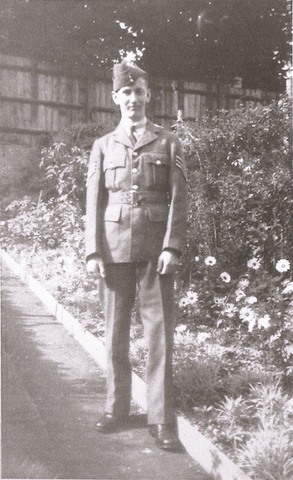
Ron Durbridge at 37 Addison Road. Reproduced by kind permission of David Bennett.
Ronald Durbridge was the only son of Mr. and Mrs. C.H. Durbridge, 37 Addison Road. His death "on active service", was reported in the Surrey Advertiser, 29th March 1941. The article went on to say that he was educated at Central School, Guildford, and before the War worked at the Cow and Gate Laboratories, Guildford. As a member of the Royal Air Force Voluntary Reserve he was called up at the beginning of the War.
37, Addison Road, was occupied by the Durbridge family for many years. The 1901 Census, records the Durbridge family at number 37, headed by Fielder Durbridge, a bricklayer. His son, aged 8 at the time, was Charles H. Durbridge, who was the only son amongst four children.
The St. Luke's Baptism registers show that Charles and Rosina Durbridge of 37, Addison Road had a son, Ronald Charles baptised on 26th September 1920. Charles' occupation was a Laundry Engineer.
On 5th April, 1941, the Surrey Advertiser described Ronald's funeral at Stoke Cemetery. The coffin was draped with the RAF flag and the Last Post was played over the grave. Before the internment there was a service at St. Luke's church, Charlotteville, where Ronald had been a choirboy.
From "RAF Coastal Command Losses of the Second World War - Volume 1" (Ross McNeill, 2003), 22nd March 1941, 612 Squadron lost a Whitley V, number T4287 WL-, and three crew. The crew were Sgt. R.C. Durbridge, P/O W.F. Crockart and Sgt. B.J. Holden. The aircraft hit a house on approach to Dyce, the Squadron's base in Scotland) and crashed onto a railway station at Stoneywood, Aberdeenshire.
No 612 Squadron was a general reconnaissance squadron, flying Avro Ansons from July 1939 on coastal patrols. In November 1940, the Squadron began to convert to Whitleys and these flew their first patrols in February 1941.The Squadron's duties included escorting convoys, searching for and attacking enemy submarines and surface vessels and reconnoitring the Norwegian coastal area.
The Whitleys were nicknamed "coffin boxes" because they were shaped like a coffin, painted all black at that time, flew with their nose down, and were dreadfully slow and sluggish. If one engine failed it was impossible to maintain height.
Ronald is buried in Stoke New Cemetery, Guildford. Grave reference Block P. Grave 227.
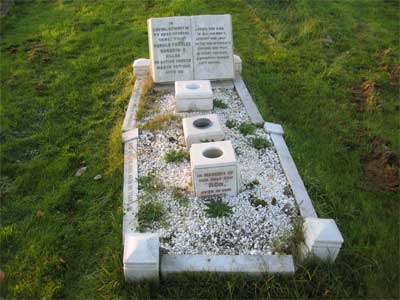
Adrian Walter Hayes
Sapper 6085854, 11 Field Coy., Royal Engineers, died Wednesday 4th September 1940. Age 23.
Adrian was the son of Mr. W. J. Hayes, 132 Addison Road.
The Surrey Advertiser, 7th September, 1940, reported his death as being the result of a road accident in Lincolnshire. He had been a pupil of Charlotteville and Holy Trinity schools, and before the War had worked for the Initial Towel Company. He had been a Territorial soldier.
His funeral, at Stoughton Cemetery, was attended by his family and representatives from his unit, including a bugler corporal from the Royal Engineers, who played the 'Last Post'. (Surrey Advertiser, 14th September, 1940).
Adrian is buried in Stoke New Cemetery, Guildford. Grave Block B, Grave 382.
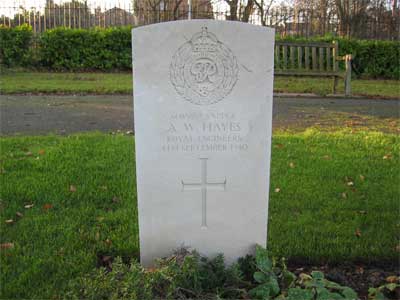
George Malgwyn Hayes
Private 6085839, 1st, Special Air Service Regiment, A.A.C., died Saturday, 17th June 1944. Age 28.
George was the son of George Frederick and Lizzie Hayes, of 62 Addison Road.
Following the legendary success of the Special Air Service (S.A.S) in North Africa, the Regiment was to play a key role in the Normandy landings by disrupting the supply lines of the Germans fighting the invasion, causing havoc and confusion amongst the enemy and gathering vital intelligence.
In "The SAS at War" by Anthony Kemp, several different operations involving the 1st SAS in France, in June 1944, are described. In one operation, a base was set up west of Dijon, code name Houndsworth. Three aircraft took-off from Fairford to drop the bulk of the personnel on the night of the 16th June. Two of the aircraft failed to find their dropping-zones and returned to base. The third containing Lt. Cairns and fourteen men completely disappeared and was presumed to have crashed. "The occupants are remembered on the Bayeux Memorial for those with no known grave".
Further details of this flight are also on the web-site of the Harrington Aviation Museum (www.harringtonmuseum.org.uk), who have compiled a list of all the aircraft lost whilst on special duty operations during the War.
George Hayes is listed along with Lt. Cairns and 13 other SAS soldiers on this website. It appears he was on a Stirling bomber which failed to return from a mission to re-supply Operation Houndsworth. The bomber, serial number LJ850Y, from 620 Squadron RAF, is believed to have crashed into the English channel with the loss of all six crew and the 15 SAS men.
George is commemorated on the Bayeux Memorial, Calvados, France. Panel 18, Column 2.
Up-date 07/03/2010 - More details about the fatal flight, including a photograph of the plane George was a passenger in, are in a recent book "Stirlings in Action with the Airborne Forces" by Dennis Williams, Pen and Sword Aviation, 2008. The book includes a Roll of Honour which includes George and all the men lost on this flight.
The web-site www.SpecialForcesROH.com features a roll-of-honour for all the S.A.S. men lost in World War II. As well as the details above, it shows George was born in Glamorgan and his parent unit was the Army Air Corps and formerly the Welch Regiment. It adds that he was in "D Squadron" 1st. S.A.S.
Up-date 05/11/2017 Recent newspaper articles have recently revealed that the wreckage of Stirling LJ850Y have been discovered in Northern France. A campaign is underway to allow a proper excavation of the site.www.dailymail.co.uk
Return to Roll of Honour TableReginald Arthur Knapman
Sergeant 1312487, 9 Sqdn., Royal Air Force Volunteer Reserve, died Saturday, 1st May 1943. Age 31.
Reginald was the son of Mr. A. J. and Agnes Caroline Knapman, of Guildford, Surrey (CWGC citation).
Although there is no entry for Reginald in the St. Lukes Registers there is a record of a Dorothy Knapman, daughter of James and Agnes Knapman of 74 Cline Road baptised in April 1928. James Knapman's occupation was "fireman".
In February 1939, No. 9 Squadron moved to Honington and received Wellington bombers, and it was with these that it was involved in anti-shipping sorties in the early stages of World War II.
The Wellington was replaced by the famous Lancaster bomber in September 1942 and the squadron became part of Bomber Command's strategic offensive against German targets and was now based at Waddington (8th August 1942 - 14th April 1943).
Following a move to nearby Bardney, No. 9 Squadron, specialised in dropping large bombs and the 12,000lb (5,440kg) 'Tallboy' in particular.
On the night of 30th April/1st May 1943, a Lancaster III, ED838 WS-R, took off from Bardney, on a bombing mission to Essen. Amongst the crew of 7, were the pilot, Pilot Officer George Nunez, and the wireless operator, Sergeant Reginald Knapman.
The plane was lost without trace. (RAF Bomber Command Losses of the Second World War: 1943 v. 4 by W.R. Chorley)
Reginald's crew was the first to be reported missing from Bardney, which was only opened in April 1943.
The raid on Essen, 30 April/1 May 1943, involved a total of 305 aircraft - 190 Lancasters, 105 Halifaxes, and 10 Mosquitos.. Cloud was expected over the target so a Pathfinder technique based solely on Oboe Mosquito skymarkers was employed. The plan worked well and 238 crews reported that they had bombed Essen, and the Krupps factory was hit again. Total losses were 6 Halifax's and 6 Lancasters. (www.raf.mod.uk/bombercommand)
Reginald is commemorated on the Air Forces Memorial at Runnymede, Panel 156, alongside over 20,000 airmen who were lost in the Second World War during operations from bases in the United Kingdom and North and Western Europe, and who have no known graves.
Up-date 31/01/2010 - I have recently been contacted by a lady, who spent part of her childhood at number 111 Cline Road, from about 1937. She recalls Reginald Knapman lining the children up and pretending to take a photo of them, although there was no film in the camera.
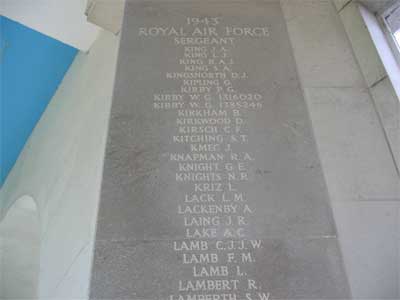
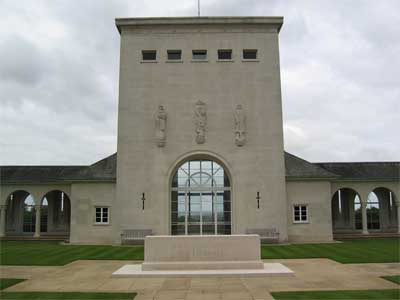
Arthur Albany Peters
Corporal 6089218, 1/5th Bn., The Queen's Royal Regt (West Surrey), died Sunday, 26th May 1940. Age 29.
Arthur Peters was the son of Jesse and Ada Alice Peters, of 45 Cline Road, Guildford, and the husband of Marjorie Edith Peters, also of Guildford. (CWGC Citation). During the First World War, Arthur's father, Jesse, had also served with the Queen's and played the bugle at the unveiling of the Charlotteville war memorial in 1928 (Surrey Advertiser, 19/12/28 and Army service records) (See Other Local Men)
From History of the Queen's (Vol VIII), we know that the 1/5th Queen's were embodied at Guildford in September 1939, and were sent to guard key points in Sussex, before intensive training in readiness for War.
Together with the 1/6th and 1/7th Battalions Queen's the 131st Brigade continued training in Dorset, before receiving standing orders to move to Finland. The mission to Finland was cancelled, and after inspection by the King in February 1940, the Battalion and the rest of the Brigade, eventually embarked at Southampton on 2nd April and sailed to Cherbourg.
The Queen's first saw action in Belgium, where they were involved in the defence of the Escaut Canal, 16th - 21st May 1940.
The battalion's Carrier Platoon (Carriers were small armoured vehicles usually equipped with a machine gun, such as a Bren gun) was ordered to assist the 2nd Buffs at Petegem, where the enemy had crossed the canal north of Escaut. (History of the Queen's (Vol VIII, p. 74)).
On May 21st. the Carrier Platoon, under the command of Major Lord Sysonby attacked the village from the west. The carriers continued on for over a mile behind the German lines.
One carrier commanded by Corporal Peters was hit by an anti-tank shell and put out of action. Corporal Peters had his thigh shattered and the two members of his crew were made prisoner. Sergeant Wynn with two of the other carriers most gallantly rescued Peters under heavy fire, a deed for which he received the DCM.
From the Surrey Advertiser, 1st June 1940, we know that Arthur lived at 70 Addison Road, with his wife and two-year old daughter. He died at Ashridge War Hospital, Berkhamsted, following an operation necessitated by the wounds received whilst fighting with the B.E.F. in Belgium.
Before the War, Arthur worked at the Friary Brewery and joined the Territorials in 1938. He was called up at the outbreak of war.
Arthur's family were well known in the area, his brother was a warden at St. Luke's church and his uncle Mr. Albany Peters was the Town Crier.
Among the long list of people who sent flowers, were "the boys of the Carrier Platoon, 1/5th Queen's".
The funeral service was held at St. Luke's, and Arthur is buried in Guildford Cemetery. Block H. Grave 138.

Peter Jessie Snelling
Peter Jessie Snelling was born 16th October 1920 (not 27th February as I reported previously) to Henry Albert and Ada Clara Snelling of 125 Addison Road (St. Luke's Parish registers), but I can find no mention of him in the CWGC website or in the Surrey Advertiser.
Updated 02/02/2010 - Following my request for information in the Surrey Advertiser (22/01/10) I have been contacted by two people who remember the Snelling family residing near the church in Addison Road. This ties in with Henry Snelling's family who resided at 125 Addison Road. Number 125 is near the former church site.
One of my contacts even worked with Peter Snelling's brother, Doug, before the War and served with him during the War. Unfortunately neither correspondent knew if Peter Snelling died in the War.
These leads suggested that the connection must be with this family, so I carried out an on-line search of Death certificate registers. One entry stood out, that of Peter J. Snelling age 24, died in 1945, in the Surrey Mid-East registration district. A copy of the certificate was purchased which revealed Peter Jessie died in St. Anthony's Hospital, Cheam, 6th April 1945 age 24. Cause of death was "Meningitis Tuberculous".
Peter's address was given as 125 Addison Road, Guildford and the informant was his father, H. A. Snelling. For occupation the entry was "formerly A.C.1 No.1210180 R.A.F." and then on the next line "(Shoe salesman)"
The certificate shows he was an Aircraftsman 1st Class and 1210180 his RAF service number, hence his eligibilty to be included on the memorial.
Updated 16/06/2011 Peter's sister, Mrs Mabel Dowling, has recently been interviewed by Tieleke Williams of the Charlotteville Jubilee Trust local history project. Mrs Dowling says her brother Peter was known to everyone as Jim. He joined the RAF Volunteer Reserve before war broke out. Whilst stationed in Wales he underwent an unsuccesful ear operation and reacted badly to treatment with penicillin. He was bed-ridden for some time, so long in fact that his body grew two inches. With financial help from the RAF his parents were able to visit him for a week in Wales before he was moved to St Anthony's Hospital, Cheam, where he finally lost his fight with the illness.
Mrs. Dowling has Peter's original discharge certificate which shows he was an "armourer". Date of enlistment is 21.11.40 and he reported for regular service 27.2.41. He was discharged as physically unfit for Air Force service 18th May 1944. Character and general conduct were both very good. There is no indication of which Squadron he served with.
Mrs Dowling has kindly allowed me to publish the photograph of her brother and a copy of the hospital menu from Christmas 1944.
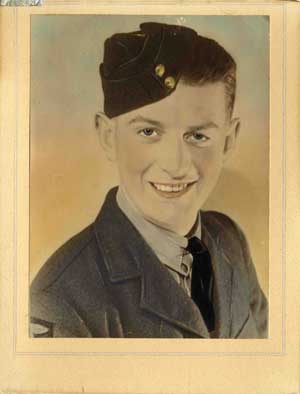
Peter Jim Snelling. Reproduced by kind permission of Mrs Mabel Dowling.

Hospital Menu Christmas 1944. Reproduced by kind permission of Mrs Mabel Dowling.
Herbert Walter Washington
Civilian, died Monday, 12th May 1941. Age 38.
Herbert Washington, lived at 79 Cline Road with his wife, Dorothy May Washington. He was the son of Herbert and Agnes Washington, of 10 Cheselden Road. (CWGC Citation).
Herbert was injured by a bomb falling in Cline Road, and died later on the same day at Warren Road Hospital. He is buried in Guildford Civilian cemetery.
A report of the bombing appears in the Surrey Advertiser, 17th May 1941, although no street names are given, for security reasons, the accompanying photograph, clearly shows a crater and a demolished house, in Addison Road, at the bottom of the footpath leading to Pewley Way.
The article describes how, on Monday morning, a German "night-raider" dropped a "stick" of high-explosive bombs, onto a suburb of a "home counties town", killing one person and seriously injuring four more.
"The plane flew low over the housetops, wheeled and released the bombs, two of which burst in roadways and one in a back garden."
"Some houses were wrecked and many others had windows and roofs smashed and doors blown off."
St. Luke's church hall was quickly converted into a rest centre and a mobile canteen was quickly on the scene.
The same page carried a report on the funeral of Herbert Washington, but does not explain the cause of death. The funeral took place on Thursday 15th May, after a service at Holy Trinity church. It gave Herbert's age, 38 years old, and stated that he was employed at the Alexandra Laundry.
Herbert is buried in Guildford Cemetery.
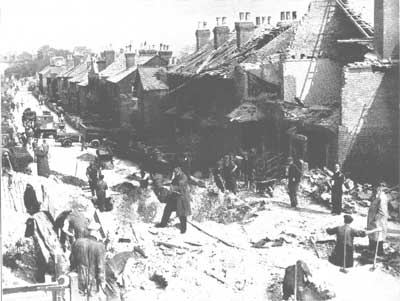
Bomb Damage in Addison Road. From David Rose Collection. Reproduced by kind permission of David Rose.
Updated 10/02/2010 A letter on the Charlotteville web-site (Charlotteville web-site) from Colin Saville gives a very good account of Cline Road in the War years. The letter states that house numbers 71, 73, 64 and 66 Cline Road were all badly damaged by the bombs that were dropped that night.
I have also been contacted by a lady who lived in Cline Road during the War. Her father, Mr. Porter, was first to the scene and discovered Herbert Washington's body. She also told how the steep bank between Addison and Cline Road which forms the back gardens of the even-numbered houses helped protect those houses by absorbing some of the blast.
Living in number 111 Cline Road, she had a good view of the hospital grounds (now St. Luke's housing development) and would watch the wounded soldiers convelescing there.